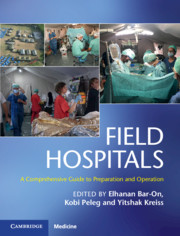Book contents
- Field Hospitals
- Field Hospitals
- Copyright page
- Contents
- Contributors
- Preface
- Section 1 History
- Section 2 Scenarios
- Section 3 Operational Considerations
- Section 4 Clinical Considerations
- Chapter 13 Advanced Triage Management for Emergency Medical Teams
- Chapter 14 Medical Aspects in a Field Hospital
- Chapter 15 Pediatrics in a Field Hospital
- Chapter 16 Surgery in a Field Hospital
- Chapter 17 Wound Management in a Field Hospital Environment
- Chapter 18 Orthopedics in a Field Hospital
- Chapter 19 Burn Care in a Field Hospital Environment
- Chapter 20 Obstetrics and Gynecology in a Field Hospital
- Chapter 21 Otolaryngology and Maxillofacial Surgery in a Field Hospital
- Chapter 22 Ophthalmology in a Field Hospital
- Chapter 23 Anesthesia and Pain Management in Field Hospitals
- Chapter 24 Intensive Care Unit Buildup Within a Field Hospital Setting
- Chapter 25 Infectious Diseases and Public Health in a Field Hospital
- Chapter 26 Primary and Ambulatory Care in a Field Hospital in Disaster Areas
- Chapter 27 Mental Health in a Field Hospital
- Chapter 28 Nursing in a Field Hospital
- Section 5 Additional Contextual Considerations
- Index
- Plate Section (PDF Only)
- References
Chapter 14 - Medical Aspects in a Field Hospital
from Section 4 - Clinical Considerations
Published online by Cambridge University Press: 09 January 2020
- Field Hospitals
- Field Hospitals
- Copyright page
- Contents
- Contributors
- Preface
- Section 1 History
- Section 2 Scenarios
- Section 3 Operational Considerations
- Section 4 Clinical Considerations
- Chapter 13 Advanced Triage Management for Emergency Medical Teams
- Chapter 14 Medical Aspects in a Field Hospital
- Chapter 15 Pediatrics in a Field Hospital
- Chapter 16 Surgery in a Field Hospital
- Chapter 17 Wound Management in a Field Hospital Environment
- Chapter 18 Orthopedics in a Field Hospital
- Chapter 19 Burn Care in a Field Hospital Environment
- Chapter 20 Obstetrics and Gynecology in a Field Hospital
- Chapter 21 Otolaryngology and Maxillofacial Surgery in a Field Hospital
- Chapter 22 Ophthalmology in a Field Hospital
- Chapter 23 Anesthesia and Pain Management in Field Hospitals
- Chapter 24 Intensive Care Unit Buildup Within a Field Hospital Setting
- Chapter 25 Infectious Diseases and Public Health in a Field Hospital
- Chapter 26 Primary and Ambulatory Care in a Field Hospital in Disaster Areas
- Chapter 27 Mental Health in a Field Hospital
- Chapter 28 Nursing in a Field Hospital
- Section 5 Additional Contextual Considerations
- Index
- Plate Section (PDF Only)
- References
Summary
The medical contingent of the field hospital has different roles to play as the deployment continues, due to the changing case load and breakdown of patients and disease. If deployment occurs more than a few days from the event, the need for medical (as opposed to surgical) personnel will increase. This is due to the need to treat chronic medical conditions- due to the collapse of local medical services- and to treat infectious disease (wound infections) and to prevent and treat disease outbreaks.
Preparation for the mission will ultimately determine its success, due to the very short interval between the decision to deploy and deployment. Team preparation should ideally form a vaccinated group who will form the basis of those deployed.
The team must be self-sufficient in most aspects, taking only the minimum from the community: this will require requisition of many items and training in their use.
Infectious diseases personnel will not only guide treatment of patients but also be responsible for the health of the team and disease prevention.
The laboratory is an essential part of the team: microbiology capacity will enable guiding of treatment decisions by identifying antibiotic resistance.
Keywords
- Type
- Chapter
- Information
- Field HospitalsA Comprehensive Guide to Preparation and Operation, pp. 133 - 139Publisher: Cambridge University PressPrint publication year: 2020



